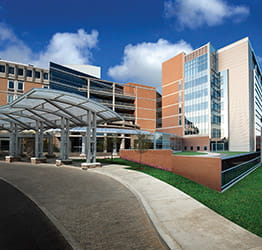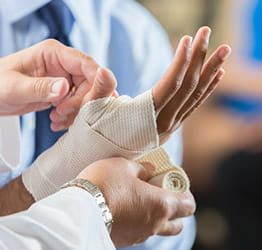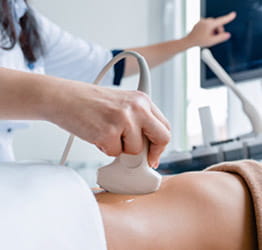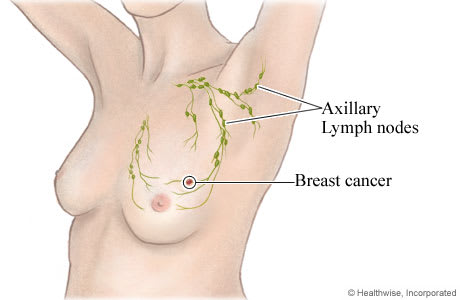What Is Axillary Lymph Node Dissection?
If you have a sentinel lymph node (SLN) biopsy after a breast cancer diagnosis and the results show that cancer may be present in your lymph nodes, your surgeon may recommend an axillary lymph node dissection. During an axillary lymph node dissection, your surgeon will remove all or a group of lymph nodes in your axilla (armpit).
What happens when axillary lymph nodes are removed?
After your procedure, your lymph nodes will be tested for cancer. Your UPMC breast cancer care team will use this information to determine the stage of breast cancer you have and recommend a personalized treatment plan.
Axillary Lymph Nodes and Breast Cancer
Your lymphatic system — which carries white blood cells that fight infection — is a major pathway through which cancer cells can spread to other areas of your body. If breast cancer cells break through the duct or lobe and invade the surrounding breast tissue, they have the potential to travel to the lymph nodes under your arm.
Removing your lymph nodes during an axillary lymph node dissection and testing them for cancer cells can help your doctor determine if your breast cancer has spread to your lymph nodes or other parts of your body.
Axillary lymph nodes
The lymph nodes in your underarm area are called axillary lymph nodes. They play an important role in the diagnosis and treatment of breast cancer. You have lymph nodes throughout your body. When cancer cells reach the lymph nodes, the cancer can spread to other parts of your body more easily. By looking at some of these lymph nodes under a microscope (biopsy), your doctor can see if your breast cancer has spread to them.
A sentinel node biopsy is surgery that removes the first one or two lymph nodes that cancer would travel to from the breast. An axillary lymph node dissection is surgery that removes usually 10 to 20 nodes.
© 2016-2025 Healthwise, Incorporated. This information does not replace the advice of a doctor.
Is axillary lymph node dissection a major surgery?
Yes, axillary lymph node dissection is considered a major surgery.
Types of axillary lymph node dissection
There are three levels of axillary lymph node dissection, including:
- Level I — The least aggressive level, which involves removing all tissue below the lower edge of your pectoralis minor muscle.
- Level II — Involves removing the tissue underneath your pectoralis minor muscle.
- Level III — The most aggressive level, which involves removing the tissue above your pectoralis minor muscle.
A traditional axillary lymph node dissection usually includes removal of the nodes in levels I and II from the "fat pad" under the arm.
Why Would I Need Axillary Lymph Node Dissection?
You may need an axillary lymph node dissection if you receive a breast cancer diagnosis and a SLN biopsy shows that cancer may be present in your lymph nodes.
Who’s a candidate for axillary lymph node dissection?
You may be a candidate for axillary lymph node dissection if your doctor suspects that your breast cancer may have spread to the lymph nodes under your arm.
What Are the Risks and Complications of Axillary Lymph Node Biopsy?
Removing the lymph nodes in your underarm area can affect the way your body moves lymph fluid through your system, increasing your risk of developing lymphedema. Lymphedema causes swelling in your arm, which can lead to wounds and infections if left untreated.
Other complications may include:
- Axillary web syndrome, which causes scar tissue and pain that can make it difficult to move your shoulder.
- Bleeding.
- Damage to your nerves.
- Infection.
How painful is axillary lymph node dissection?
You may have moderate to severe pain at your incision site in the first few days after your procedure, depending on the extent of your surgery. However, the discomfort should improve after a few weeks and be completely gone after six to eight weeks.
Many people also have shoulder stiffness and pain. Physical therapy and pain medication can help treat these symptoms.
What Should I Expect From Axillary Lymph Node Dissection?
Before: How to prepare for axillary lymph node dissection
To prepare for the procedure, you should:
- Fast for a certain period of time prior to the procedure. Your doctor will inform you if you need to fast and, if so, how long to fast (typically overnight).
- Have any tests that your doctor recommends. For example, your doctor may request a blood test before the procedure to determine how long it takes your blood to clot.
- Tell your doctor if you are sensitive or allergic to any medications, iodine, latex, tape, or anesthetic agents (local and general).
- Tell your doctor about all medications (prescription and over-the-counter) and herbal or other supplements you are taking.
- Tell your doctor if you have any other health conditions. Your care team may need to take certain precautions during your procedure for your safety.
- Tell your doctor if you have a history of bleeding disorders or if you are taking any blood-thinning medications, aspirin, or other medications that affect blood clotting. You may need to stop some of the medications prior to the procedure.
- Tell your doctor if you are breastfeeding, pregnant, or think you might be pregnant.
On the day of your procedure, please bring your photo ID and health insurance card(s). Leave valuables such as cash and jewelry at home.
You may be discharged the same day as your surgery, or you may need to stay in the hospital overnight. Your doctor will let you know what to expect.
If you need to stay overnight, you should bring toiletries, a robe, slippers, a cell phone and charger, medications, and a change of clothes. You will also need to arrange for someone to drive you home after you are discharged.
How long does axillary lymph node dissection take?
Axillary lymph node dissection takes one to three hours, depending on the extent of the procedure.
During your axillary lymph node dissection
When you arrive at the hospital, you will meet with your care team for final preparations.
You will receive an IV in your hand or arm. You will have general anesthesia to put you to sleep.
During your axillary lymph node dissection, your surgeon will:
- Make an incision in your underarm area.
- Remove your lymph nodes.
- Send your lymph nodes to the lab to test for signs of cancer.
- Place a surgical drain to remove excess fluid from the surgical site.
- Close your incision and cover it with a bandage.
Recovery after axillary lymph node dissection
After your procedure is complete, you will be monitored in the recovery area. If you are staying overnight in the hospital, you will be transferred to your room. If you are discharged the same day, you will be released from the hospital when your condition is stable.
Whether you stay overnight or are discharged the same day, you will need to arrange for someone to drive you home from the hospital.
Before you go home, your doctor will tell you:
- How to care for your wounds and watch for signs of infection or complications.
- What medications you need to take.
- When to call your doctor or 911 if you have certain symptoms.
- When to schedule your follow-up appointments, if they have not been scheduled already.
- When you can return to your normal activities, such as driving and bathing.
Your doctor may also recommend that you see a lymphedema specialist, who can monitor your condition and help you reduce your risk of lymphedema after your procedure.
When to call your doctor about complications
You should let your surgeon know if you have:
- A fever of more than 100.0°F.
- Difficulty breathing.
- Pain, redness, bleeding, drainage, or increased swelling at your treatment site.
- Severe pain that does not respond to medication.
- Swelling in your arm or hand.
Axillary Lymph Node Dissection Recovery Process
Most people can resume their normal activities and return to work four to six weeks after an axillary lymph node dissection. If your surgeon placed a surgical drain, it will be removed after about a week.
You may experience symptoms that should gradually improve over several weeks, including:
- Pain.
- Reduced range of motion in your arm and shoulder.
- Swelling.
Your doctor will give you instructions on how to care for your incision, along with exercises to improve the range of motion in your arm and shoulder. Additionally, your doctor may refer you to a physical therapist to help improve your arm strength and a lymphedema specialist to monitor your condition and reduce your risk of developing lymphedema.
You will need to avoid lifting, pushing, or pulling for several weeks, and should attend all follow-up appointments.
What are the long-term effects of axillary lymph node dissection?
Long-term effects of axillary lymph node dissection may include:
- Chronic pain.
- Lymphedema.
- Numbness, tingling, or burning sensations in your arm, hand, or fingers.
- Reduced range of motion in your shoulder.
- Scar tissue in your armpit area.
What do the results of my axillary lymph node dissection mean?
Your doctor will send the removed lymph nodes to the lab, where a pathologist will check them for signs of cancer. Based on the results, your doctor will develop a personalized treatment plan for you.
Axillary lymph node dissection test results may include:
- Negative lymph nodes — No cancer cells found in any of the removed lymph nodes.
- Positive lymph nodes — Cancer cells are found in one or more removed lymph nodes. The pathology report will also show how many and which lymph nodes were positive, and whether the cancer cells spread beyond the lymph node to surrounding tissue.
Why Choose UPMC for Axillary Lymph Node Dissection?
When you choose UPMC for axillary lymph node dissection, you will receive:
- Access to advanced diagnostic technology — Our experts use the latest diagnostic technology to quickly and accurately identify signs of cancer.
- Convenient imaging services — Imaging appointments are available at multiple locations with hours that fit your schedule.
- Multidisciplinary care — We partner with breast surgeons, medical oncologists, radiation oncologists, breast reconstructive surgeons, and other medical experts to treat breast cancer and other breast conditions.
By UPMC Editorial Staff. Last reviewed on 2025-09-18.

















